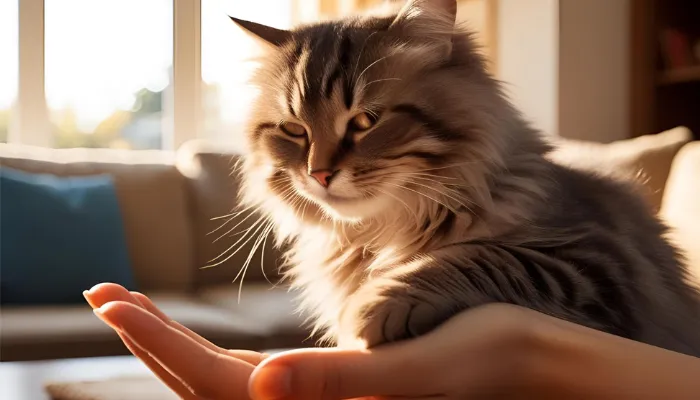How Do I Say “Hello” in Cat Translator? If you have ever wanted to speak to your cat, look no further. This can help strengthen the relationship between you and your loved feline. Now, a Cat Translator might not accurately represent how human translators function, nevertheless, cats do have their own set of greetings that can be translatable.
In general, cats say “hello” via mewing, purring, moving their body around or even blinking at humans. Let us discover the ‘how’ in saying “hello” and optionally interpreting their responses.

Understanding Cat Communication
Before knowing how to greet a cat, it is fundamentally vital to grasp their communication techniques. Cats use their vocal cords differently and have distinct body movements to engage with both humans as well as other cats.
Ways Cats Communicate:
- Meows – Usually directed at humans, not other cats.
- Purring – Indicates comfort or a request for attention.
- Tail Movements – A raised tail often signals a friendly greeting.
- Slow Blinking – A sign of trust and affection.
- Ear Positions – Forward ears show interest, while flattened ears indicate distress.
Understanding cat communication helps build trust and a stronger bond. Recognizing their signals ensures better interactions with your feline friend.
Cat Greetings: Blinking, Meowing & Touch
There are several ways to say a cat’s version of “hello.” Try to imitate some of the activities that your pet usually does when saying hello to them.
1. Slow Blink Method
- Make eye contact with your cat.
- Slowly close and open your eyes.
- Wait for your cat to blink back as a sign of recognition.
2. Soft Meow or Chirp
- Some cats respond well if you mimic their sounds.
- Use a gentle tone to avoid startling them.
3. Extend a Finger
- Slowly reach out a single finger near their nose.
- If your cat sniffs and rubs against it, they acknowledge your greeting.
Learning How Do I Say “Hello” in Cat Translator strengthens your bond with your feline. Using blinks, sounds, and gestures helps create a connection they understand.
Common Cat Greetings and Their Meanings
Cats greet in different ways. Below is a table showing common cat behaviors and their meanings:
| Cat Behavior | Meaning |
|---|---|
| Slow Blinking | Friendly greeting, trust signal |
| Head Bunting | Marking you with their scent, showing affection |
| Tail Up and Curved | Happy to see you |
| Chirping or Trilling | Friendly and excited greeting |
| Rubbing Against You | Acknowledgment and affection |
Understanding common cat greetings helps strengthen your connection with your feline. Recognizing their signals ensures better communication and trust.
Greeting Your Cat: Soft Tones & Positive Reinforcement
To strengthen your bond with your cat, repeat friendly greeting behaviors regularly. Cats appreciate routine and consistent interactions.
4. Speak in a Soft Voice
- High-pitched, soft tones are more welcoming to cats.
- Avoid loud or deep voices as they may seem threatening.
5. Use Their Name with Positive Reinforcement
- Say their name in a loving tone.
- Reward them with treats if they respond positively.
Repeating How Do I Say “Hello” in Cat Translator builds trust and strengthens your bond. Using soft tones and positive reinforcement makes interactions more welcoming.
Cat Body Language: Understanding Their Greetings
Cats rely heavily on non-verbal communication. Understanding their body language helps interpret their responses.
- If a cat flicks its tail while greeting, it may be excited or playful.
- Ears forward indicate interest, while ears back signal discomfort.
- Lying down and exposing the belly is a sign of trust but not necessarily an invitation to pet them.
Mastering How Do I Say “Hello” in Cat Translator enhances your bond with your cat. Recognizing body language cues ensures better communication and trust.
What to Avoid While Greeting a Cat?
Some actions might unintentionally make a cat feel uncomfortable. Here’s what to avoid:
6. Sudden Movements
- Quick hand gestures can startle a cat.
- Approach them calmly and steadily.
7. Direct Staring
- Long, unbroken eye contact can be intimidating.
- Instead, use slow blinking.
8. Overwhelming Touch
- Not all cats like head pats or belly rubs immediately.
- Let them initiate physical contact.
Respecting a cat’s boundaries builds trust and a positive connection. Avoiding sudden moves, staring, or forced touch helps create a stress-free bond.
Consistent Cat Greetings: Building Trust Over Time
Consistency is key when communicating with cats. They respond best to repeated actions over time.
- Use the same greeting techniques daily.
- Observe how your cat reacts and adjust accordingly.
- Be patient—trust takes time!
Practicing How Do I Say “Hello” in Cat Translator strengthens your bond over time. Consistency and patience help build trust and understanding with your cat.
Conclusion
How Do I Say “Hello” in Cat Translator? The best greetings would come in a mixture of sounds, accompanied by slow blinking and gentle movements. By paying attention to the cat’s body language, one can understand their words. Each cat’s communication style is different, which makes a strong bond possible because there is a Cat Translator that does not exist, but simulating their nature enables a way to communicate. Just keep trying and I am more than sure that the next time you will be greeted with purring, blinking, and tailing flicking right behind your back!
